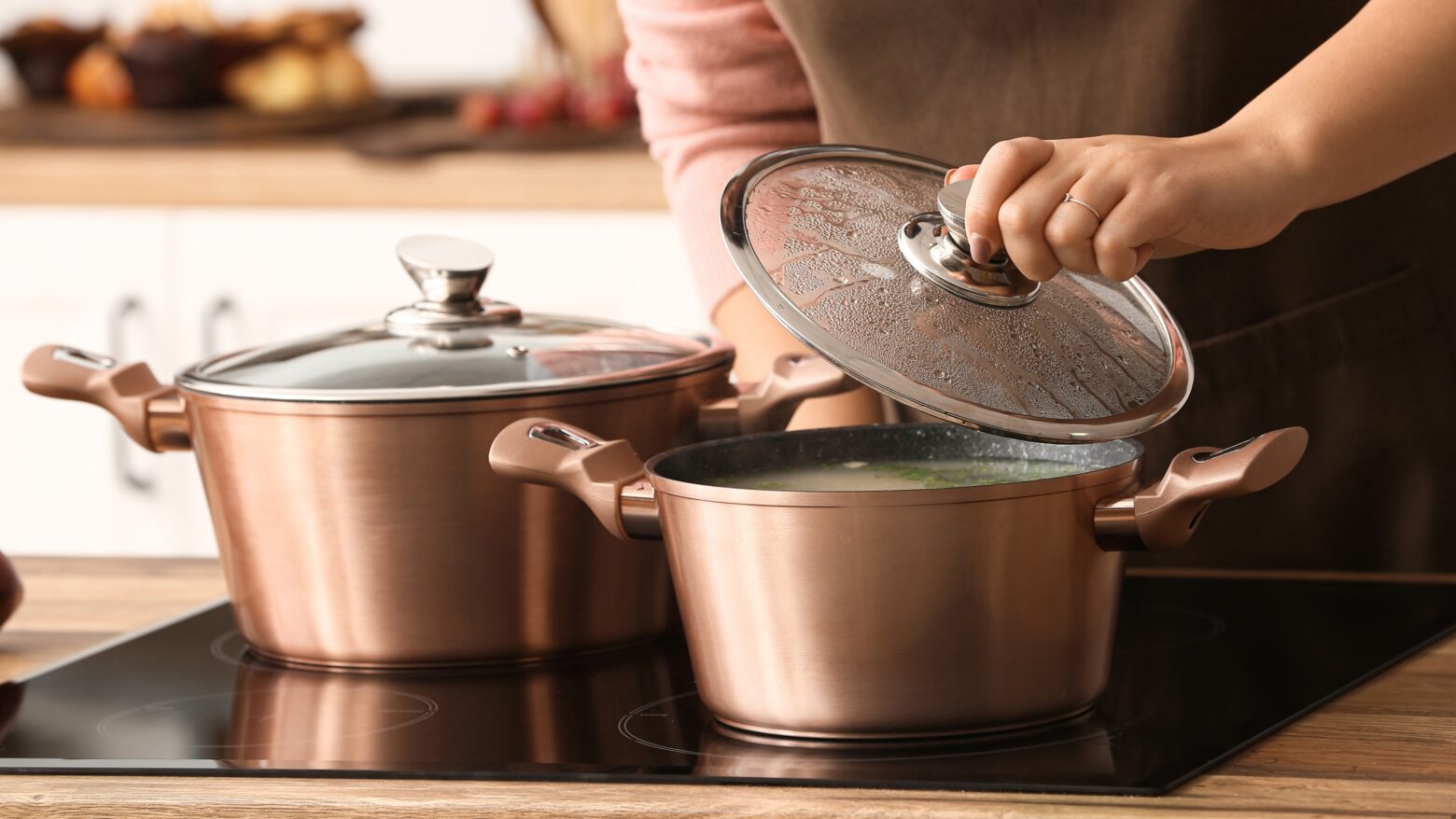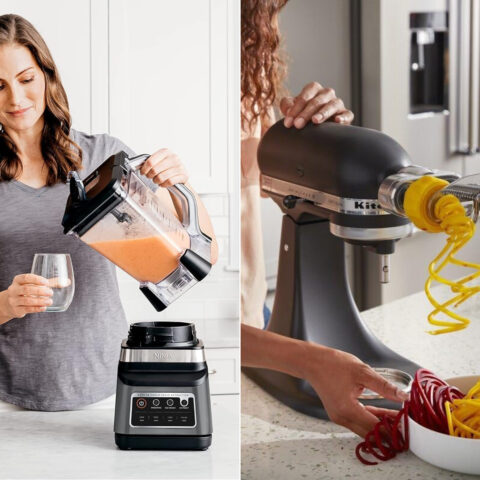Choosing the Right Non-Toxic Cookware

Since The Paleo Diet® focuses on avoiding synthetic foods and emulating the diets of our ancestors, it’s fitting that our cookware aligns with those same principles. Here’s what you need to know about finding healthy, non-toxic cookware for your home.
What to Watch Out for in Modern Cookware
Modern cookware, particularly nonstick, often contains toxic metals, plastics, and synthetic chemicals. These toxins can create health issues over time. Here’s which cookware to avoid and why.
Nonstick Cookware
Traditional nonstick cookware is full of the chemicals now known as “forever chemicals.” Perfluorooctanoic acid (PFOA) is one of the per- and polyfluoroalkyl substances (PFAS) used to produce nonstick coatings like Teflon™. [1] Although many countries have phased out PFOA, older cookware may still contain it.
Polytetrafluoroethylene (PTFE) is the main component of nonstick coatings. It’s a PFAS that can release toxic fumes when overheated. These fumes can cause flu-like symptoms in humans. In fact, it’s referred to as “Teflon flu.” The toxicity is so powerful it can kill birds—much like a canary in a coal mine. [2,3]
According to the Social Science Environmental Health Research Institute, these forever chemicals are linked to many health problems, including thyroid disorders, increased risk of cardiovascular disease, reduced fertility, and even cancer. [4]
RELATED: Are PFAS in Tap Water Safe to Drink?
Newer nonstick cookware that’s advertised as PFOA- or PFOA-free is available, but that doesn’t mean it’s safe. According to the Centers for Disease Control and Prevention (CDC), there are over 9,000 PFAS currently in circulation. [5]
Other names to watch out for are hexafluoropropylete oxide dimer acid (“GenX”), PFNA, PFBS, and PFHxS. [6] These chemicals are also linked to health issues.
Aluminum Cookware
Aluminum is increasingly recognized as a potentially toxic cookware choice. When cooking acidic foods in aluminum cookware, trace amounts of the metal can leach into food. [7]
It’s well established that consuming high levels of aluminum over time can contribute to health issues. For example, some research links aluminum to neurodegenerative conditions like Alzheimer’s disease. It also may accumulate faster in those with kidney damage, as the kidneys help to filter aluminum from the body. [8,9] As aluminum levels continue to rise, they can interfere with calcium absorption. Over time, this can lead to weakened bones and even osteoporosis. [10]
Aluminum cookware isn’t always just aluminum. It can sometimes contain other metals, especially in alloys or via the manufacturing process. Scientific studies have found some aluminum cookware leaches trace amounts of lead. [11]
Ceramic-Coated Cookware (Metal Core)
Ceramic cookware sounds like a clean option but quality matters. There are two main types of ceramic cookware: 100% ceramic and ceramic coated. Ceramic-coated cookware typically has a metal core, usually aluminum or stainless steel. Because it is simply coated with ceramic, it may not be completely free of PFAS.
Non-Toxic Cookware Options
The very safest non-toxic cookware options include cast iron, carbon steel, and fully ceramic. Other good options include high-quality stainless steel, enameled cookware, and copper cookware.
Cast Iron
One of the most traditional types of cookware, cast iron is a material that can be passed on for generations. It’s naturally nonstick when properly seasoned (meaning oil is baked into the surface) and can add a small amount of dietary iron to your food. It’s safe, but those with iron overload disorders should use it cautiously. [12]
Carbon Steel
Carbon steel cookware is made of about 99% iron and 1% carbon. It shares some similarities with cast iron, but it’s lighter and easier to handle. Carbon steel also provides excellent heat retention.
Like cast iron, carbon steel is reactive, meaning it can interact with acidic foods like tomatoes or vinegar. This interaction may alter the taste and appearance of the food. However, a well-seasoned pan minimizes this issue.
When properly seasoned, carbon steel develops a non-toxic, nonstick coating. This makes it great for cooking eggs, pancakes, and other delicate foods.
Stainless Steel
Stainless steel cookware is a durable and non-reactive alloy. It’s mostly iron but may include chromium and nickel. Because it’s non-reactive, it doesn’t leach chemicals or metals when exposed to acidic foods. Unlike nonstick cookware, stainless steel doesn’t have chemical coatings. It can handle high heat without warping or degrading.
Some lower-quality stainless steel cookware may leach trace amounts of nickel and chromium into food. [13] However, this is generally not a concern with high-quality stainless steel. Look for labels with 18/10 or 18/8, indicating its chromium and nickel content. If you’re sensitive to nickel, you may want to choose a grade with lower nickel content.
Ceramic
Pure ceramic cookware is made entirely from natural clay. It’s free from metals, synthetic chemicals, and harmful toxins. The clay is baked and glazed at high temperatures to create a durable, non-reactive, non-toxic cooking surface. For those with metal allergies like nickel, pure ceramic cookware is metal free.
Enameled Cookware
Enameled cookware is made by coating metal—usually cast iron or steel—with a layer of enamel, a type of glass. The enamel layer prevents the metal core from coming into contact with food, so there’s no risk of metal leaching.
Because the enamel coating is made from natural materials like glass, it’s free from harmful chemicals such as PFOA, PTFE, lead, and cadmium. While not as nonstick as synthetic coatings, the smooth surface can resist sticking with the addition of oil or fat.
Copper
Copper cookware can be safe if lined with a non-reactive metal like stainless steel or tin. The lining prevents the copper from coming into direct contact with food, so it doesn’t react with acidic foods and leach into them. Consuming high levels of copper can lead to copper toxicity, especially when out of balance with zinc. So, if you choose to use copper cookware, make sure it’s lined. [14]
Incremental Improvements for Your Health
If you’re following The Paleo Diet, it doesn’t make sense to cook organic vegetables and grass-fed meats in pots and pans that could contaminate the food. When finances allow, seek out some of these non-toxic cookware options and stock your kitchen. Also, see what materials are safest for storing leftovers for a fully clean and Paleo-approved mealtime experience!
References
- Karstadt ML. Serum PFOA Levels in Residents of Communities Near a Teflon-Production Facility. Environmental Health Perspectives. 2007 Oct;115(10).
- Ferin J, Oberdörster G. Polymer degradation and ultrafine particles: Potential inhalation hazards for astronauts. Acta Astronautica. 1992 Jul;27:257–9.
- Sajid M, Ilyas M. PTFE-coated non-stick cookware and toxicity concerns: a perspective. Environmental Science and Pollution Research. 2017 Sep 14;24(30):23436–40.
- PFAS-Tox Database [Internet]. pfastoxdatabase.org. Available from: https://pfastoxdatabase.org/
- PFAS | NIOSH | CDC [Internet]. www.cdc.gov. 2021. Available from: https://www.cdc.gov/niosh/topics/pfas/default.html
- S EPA O. Drinking Water Health Advisories for GenX Chemicals and PFBS [Internet]. www.epa.gov. 2022. Available from: https://www.epa.gov/sdwa/drinking-water-health-advisories-genx-chemicals-and-pfbs
- Sultan S, Khan F, Wahab A, Fatima B, Khalid H, Bahader A, et al. Assessing Leaching of Potentially Hazardous Elements from Cookware during Cooking: A Serious Public Health Concern. Toxics [Internet]. 2023 Jul 24;11(7):640–0. Available from: https://www.ncbi.nlm.nih.gov/pmc/articles/PMC10386729/
- Bhattacharjee S, Zhao Y, Hill JM, Percy ME, Lukiw WJ. Aluminum and its potential contribution to Alzheimer’s disease (AD). Frontiers in Aging Neuroscience. 2014 Apr 8;6.
- Wills MR, Savory J. Aluminum and chronic renal failure: sources, absorption, transport, and toxicity. Critical Reviews in Clinical Laboratory Sciences [Internet]. 1989;27(1):59–107. Available from: https://pubmed.ncbi.nlm.nih.gov/2647415/
- E. H. Jeffery, K. Abreo, E. Burgess. SYSTEMIC ALUMINUM TOXICITY: EFFECTS ON BONE, HEMATOPOIETIC TISSUE, AND KIDNEY. Journal of Toxicology and Environmental Health. 1996 Aug;48(6):649–66.
- Fellows KM, Samy S, Whittaker SG. Evaluating metal cookware as a source of lead exposure. Journal of Exposure Science & Environmental Epidemiology [Internet]. 2024 May 21; Available from: https://pubmed.ncbi.nlm.nih.gov/38773235/
- Sharma S, Khandelwal R, Yadav K, Ramaswamy G, Vohra K. Effect of cooking food in iron-containing cookware on increase in blood hemoglobin level and iron content of the food: A systematic review. Nepal Journal of Epidemiology [Internet]. 2021 Jun 30;11(2):994–1005. Available from: https://www.ncbi.nlm.nih.gov/pmc/articles/PMC8266402/
- Kamerud KL, Hobbie KA, Anderson KA. Stainless Steel Leaches Nickel and Chromium into Foods during Cooking. Journal of Agricultural and Food Chemistry. 2013 Sep 19;61(39):9495–501.
- Royer A, Sharman T. Copper Toxicity [Internet]. PubMed. Treasure Island (FL): StatPearls Publishing; 2021. Available from: https://pubmed.ncbi.nlm.nih.gov/32491388/
Betsy Schroeder
Betsy does research and writing for a few different websites in the natural health field after taking Masters level courses in Nutrition & Functional Medicine through the University of Western States.
More About The Author



